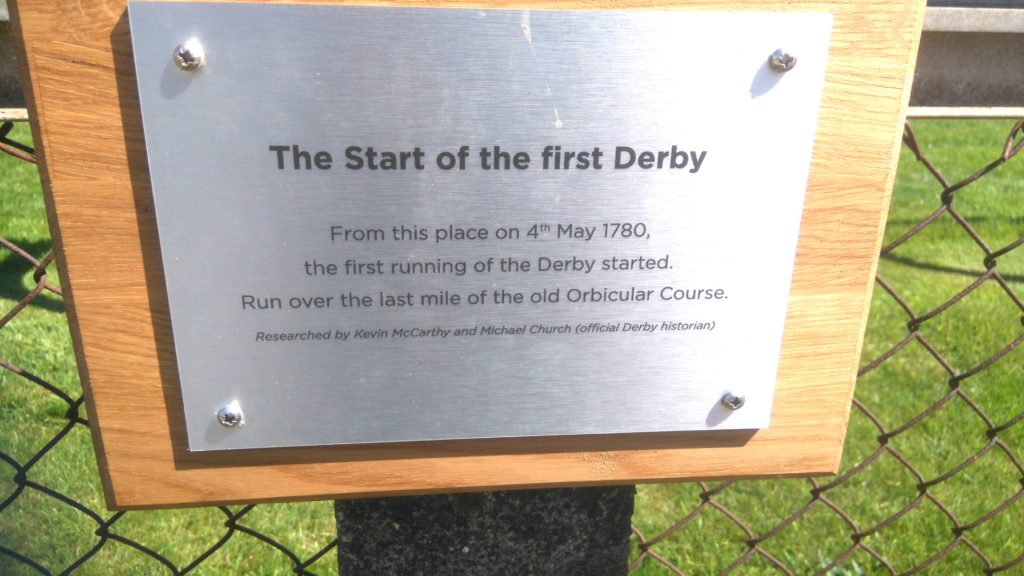Where did the first Derby start from?
The 1780 Racing Calendar states that the first Derby, was run at Epsom on Thursday, 4th of May, over “the last mile of the Course”,
But which Course?
Strangely, previous historians could not agree – Roger Mortimer, author of two large volumes of Derby history, including a map of the previous Derby Courses, which I in turn endorsed, believed it was run on the original 17th century four-mile course on Banstead Downs, the last mile turning into the Epsom home straight from a spur behind the stands (see A on the map).
In contrast, both David Hunn (author of Epsom Racecourse) and Michael Seth-Smith (in Epsom’s Official History, Derby 200), believed the original Derby Course to be a straight mile that extended beyond the current five furlong start (see B on the map).
However, our focused research eventually proved that all had been mistaken.

On New Year’s Day, 2018, I received an email from Kevin McCarthy, a local researcher and Derby enthusiast, who on a mission to locate the exact starting place of the first Derby, suggested we could solve the mystery together. We did, but not before we spent months studying ancient maps and searching through every book and newspaper relating to the history of Epsom Downs Racecourse.
To put our research into context, the early running’s of the Oaks and Derby were regarded as ground breaking events, for at this time almost all races were run in either two or four-mile heats, a horse having to win two heats to secure the prize. Many racecourses, including Epsom had a two-mile course, with the four-mile heats run over two circuits. However, in the 18th century, Epsom had both a two-mile orbicular course, situated on the site of the present racecourse and, a four-mile cross-country course which started on Banstead Downs, close to Lord Derby’s house The Oaks.
Previous researchers had then assumed the early Classics were run from the latter, and until both races were run over “the New Derby Course” in 1784, the Racing Calendar’s vague descriptions of “the last mile of the Course”, for the first Derby and the “last mile and a ½”, for the Oaks, gave historians no reason to believe otherwise.
William Kemp’s detailed 1824 map, A Plan and Survey of Epsom Race Course clearly shows that the Orbicular Course, recorded by John Toland in his 1711 publication, A Description of Epsom and its Amusement, incorporated its own internal two/four-mile course, distinct from the older one. Nevertheless, the Racing Calendar’s course descriptions could still refer to either racecourse.
Finally, a breakthrough came when finding conclusive evidence in H.E. Malden’s essay, An Eighteenth-Century Journey Through Surrey And Sussex:
“The old straight racecourse on Banstead Downs was disused about 1740, according to Salmon’s History and Antiquities of Surrey, and the “orbicular course” at Epsom, which had existed when Toland wrote thirty years earlier, had quite superseded it.”
“The old Epsom course started at Langley Bottom, out of sight of the place where the Grand Stand is now, and came round the Warren into the present course on top of the hill, and went right round from the present winning-post to Langley Bottom again. It was adapted for running four-mile heats.”. [Pp 35-36 Surrey Archaeological Collections (Bosworth & Co., Guildford, 1916)]
So at last, we had the answer. The original start of the 1780 Derby was in fact, situated at the mile post on the old Orbicular or Cup Course (see C on the map), to be found just a few yards from today’s far running rail, near the busy sand gallop – quite forgotten – until now. And therefore, for future generations history has been re-written.
In the week leading up to the 2019 Derby the Epsom management put up a plaque to commemorate the starting place of the first Derby. This was placed as near as possible to the spot, taking into consideration the nearby busy sand gallop.

The authors of this project were Kevin McCarthy and Michael Church (Official Derby Historian).
For the full academic paper click here – Full 17 page Academic Essay